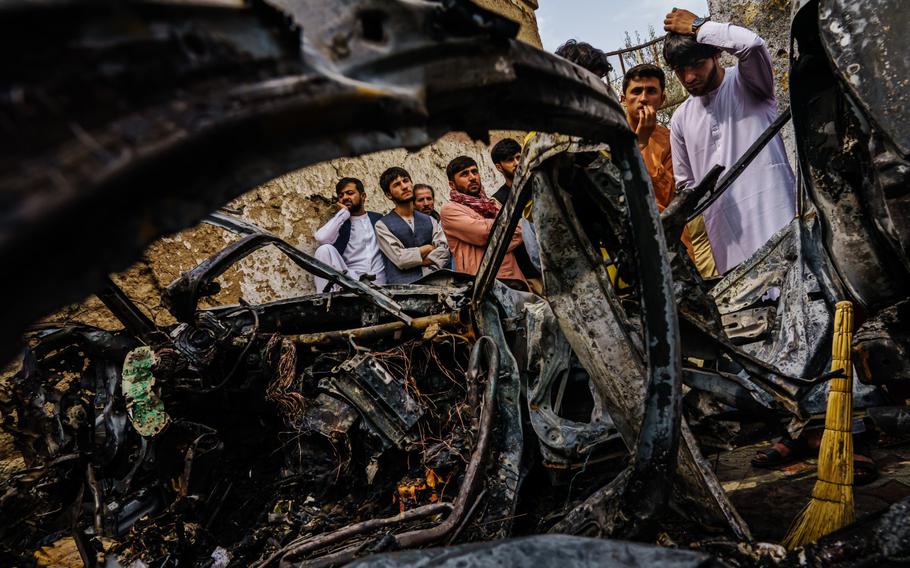
Relatives and neighbors of the Ahmadi family gather Aug. 30, 2021, around the incinerated husk of a vehicle targeted and hit a day earlier by an American drone strike, in Kabul, Afghanistan. (Marcus Yam, Los Angeles Times/TNS)
WASHINGTON — A year after U.S. forces killed seven children and three adults in an airstrike in Afghanistan, the Pentagon unveiled an action plan Thursday aimed at reducing civilian casualties during American military operations.
Among other things, the 36-page plan directs changes at all levels of military planning, training and war-fighting doctrine to include measures to mitigate civilian casualties.
“The protection of civilians is a strategic priority as well as a moral imperative,” Defense Secretary Lloyd Austin said in the document. “Our efforts to mitigate and respond to civilian harm directly reflect our values and also directly contribute to achieving mission success.”
Austin, a retired four-star general who commanded troops in Iraq and Afghanistan, ordered the new plan in January after the Pentagon acknowledged that an Aug. 29, 2021, airstrike during the U.S. evacuation from Kabul had not struck Islamic State-Khorasan terrorists but rather an innocent family in the capital.
A report by the Defense Department Inspector General found that limited communications and “confirmation bias” led to the fatal strike. The report found no evidence of criminal negligence.
Confirmation bias happens when a person interprets a series of intelligence reports or other information in a way that supports one assumption without considering alternate theories.
The Aug. 29 airstrike occurred three days after a suicide bomber killed 13 American service members and an estimated 170 Afghans crowded around the Abbey Gate at Kabul’s Hamid Karzai International Airport. The U.S. airstrike was launched after erroneous reports that extremists were on the verge of carrying out another suicide bombing.
“The plan incorporates lessons learned from recently completed studies … that have resulted in civilian casualties,” a senior defense official said Thursday. “While it’s meant to be forward looking, we’re very much informed by the lessons of those studies and the previous incidences.”
The plan calls for the Pentagon to develop a “civilian protection center of excellence” that is “really intended to be a hub and a facilitator for the DOD-wide analysis, learning and training related to civilian harm,” said the official, who spoke on condition of anonymity.
It also establishes guidance for addressing damage to civilians when it occurs, laying out how the military can understand the impacts of such cases and “how we respond more comprehensively,” the official said.
The plan also directs the DOD to develop standardized civilian harm operational reporting requirements and ways to manage such data. While the official called this the “less glamorous piece” of the plan, it is also one of the most important.
“A number of the studies [concluded that] the lack of a centralized approach across the department has hurt us,” the official said. “The action plan envisions a centralized enterprise-wide data management platform that would handle all of these [reports] and really be the foundation that allows greater collection, sharing and analysis.”
The center of excellence, which will become fully operational in 2025, also will lead efforts to build civilian harm mitigation knowledge into exercises, training and professional military exercises, according to the report. The curriculum will include lessons learned from previous operations.
“Ultimately, this plan improves DOD approach to mitigating and responding to civilian harm by creating a reinforcing framework of processes and institutions specifically designed to improve strategic outcomes and military operations,” Pentagon spokesman Brig. Gen. Patrick Ryder said Thursday.
In response to the plan, the Pentagon will add additional personnel across existing military components that will be dedicated to civilian harm mitigation and response functions, according to Ryder, who said the total amount of needed personnel has yet to be determined.